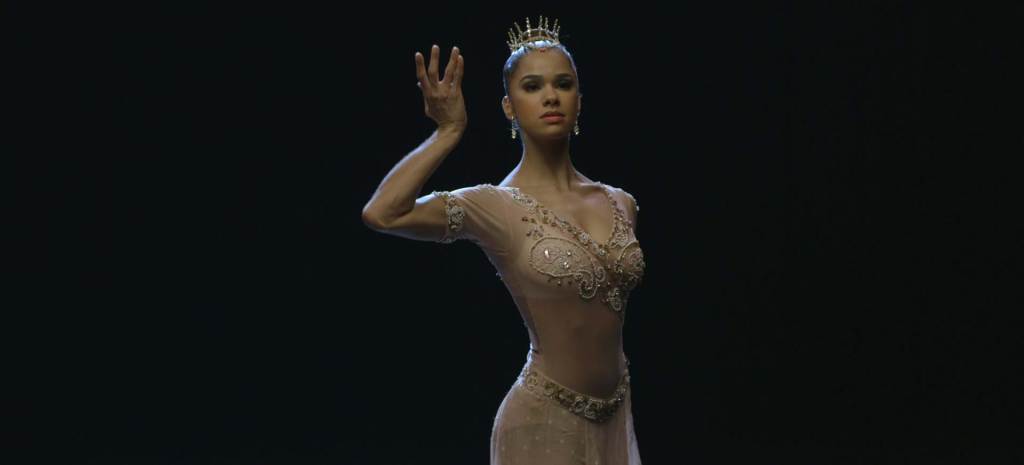
Over the past two years, Misty Copeland has become a household name. The first African American to be promoted to principal dancer in the American Ballet Theatre’s 75-year history, she was named one of Time Magazine’s 100 most influential people, has written a bestselling memoir, and even toured with Prince. Just this week, Time sat Copeland down with President Obama to discuss race, gender, and breaking barriers as African Americans in their respective fields.
Very few dancers ever reach this elite level of ballet, and fewer still become widely known. Making Copeland’s success even more remarkable: the fact that the classical ballet world is almost entirely white.
In A Ballerina’s Tale (supported by JustFims and currently available to stream on Netflix and Amazon Prime), filmmaker Nelson George documents Copeland’s historic rise against the backdrop of an artistic field sorely lacking in women of color—a disparity that’s especially stark in elite ballet companies. As Copeland herself says in the opening of the film, “There’s never been a black principal woman at the Royal Ballet, at the Paris Opera Ballet, at the Kirov Ballet, in the top companies in the world, in [the] New York City Ballet, in New York City. I don’t think that people realize what a feat it is being a black woman.”
I caught up with Nelson George and asked him about his documentary, and how Copeland’s rise has redefined traditional conventions of beauty, body, and race in the insular world of ballet.
Chi-hui Yang: Many of your films have focused on defining movements in African American arts and culture, like funk music and the black arts movement in Fort Greene, Brooklyn in the 80s and 90s. A Ballerina’s Tale focuses on the experience of one African American artist in a predominantly white artistic field. What drew you to this story?
Nelson George: It was really a happy accident. I happened to be at a cocktail party where Misty Copeland was also, and through her manager Gilda Squire I was able to buy a ticket for Misty’s performance as “The Firebird” at the Met. It was an amazing experience: my first time seeing the American Ballet Theater at one of the world’s most famous venues for classical music and dance. I thought Misty was so magnificent. She was so different from the other dancers.
After the performance at a reception on the Met stage, I was speaking to Misty and she told me that she was in a great deal of pain. She later found out that she had multiple career-threatening fractures in her left shin that she was dancing through for quite some time (these scenes make it into the movie). I knew there would be a great story in her comeback, and the film really grew out of that critical moment in her ballet career.
You followed Copeland through an incredibly dramatic period of her life under an enormous public spotlight. How did you come to see her in relation to other groundbreaking African American performers that have come before her?
Misty really is the Jackie Robinson of ballet. She is a breakthrough performer who is inspiring a new generation of young African American dancers and aspiring ballerinas. These young dancers might dream and believe that they can perform at the highest levels of classical ballet, but in Misty, now they have a successful role model who proves that it can happen.
The stories we tell each other and ourselves have the potential to shape society. What impact do you hope A Ballerina’s Tale will have in shifting cultural narratives about blackness, beauty, and high/low art?
I have no idea whether the film is shifting cultural narratives. I make films when there is a great story to be told. And this is a great story about a powerful artist at a critical turning point in her life. However, I do know that the film and Misty’s journey are impacting many young women, especially those who do ballet and want to be a part of the field of classical dance. For me this is the most important thing, since that was really my intention in making the documentary.
In making the film, what was the most surprising thing you learned about the art of ballet or about Copeland herself as a figure within it?
I got to spend a lot of time with Misty, and I have to say she is one of the strongest people I have ever met, both physically and mentally. Her focus, her ability to perform while in pain, and her artistry and spirit are matched by very few others. It was an honor to hang out with her and watch her process up close.
Having followed Misty Copeland’s journey to find recognition in perhaps one of the most traditionally white, highbrow fields—and as an African American filmmaker yourself—what’s been your reaction to the criticism around the Oscars’ lack of diversity?
Boycotts of artistry are useful. But only if they are followed up by smart networking, good strategic planning, and more good scripts. So while a conversation has been started around the lack of diversity in Hollywood and the movie industry in general, it only matters if there is follow-up on all sides.
Watch the trailer:
Accessibility Statement
- All videos produced by the Ford Foundation since 2020 include captions and downloadable transcripts. For videos where visuals require additional understanding, we offer audio-described versions.
- We are continuing to make videos produced prior to 2020 accessible.
- Videos from third-party sources (those not produced by the Ford Foundation) may not have captions, accessible transcripts, or audio descriptions.
- To improve accessibility beyond our site, we’ve created a free video accessibility WordPress plug-in.
